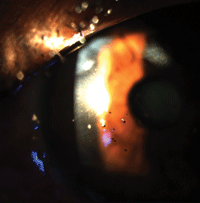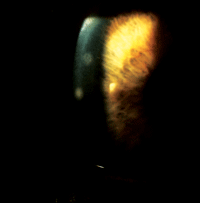 Over the past year, several new anti-inflammatory ophthalmic medications have been approved. While none of the active ingredients are novel, each of these new medications has made tremendous improvements in patient comfort, dosing consistency and tolerability. These enhancements have resulted in increased patient compliance. Understanding how these medications have improved is imperative when prescribing patients anti-inflammatory drugs.
Over the past year, several new anti-inflammatory ophthalmic medications have been approved. While none of the active ingredients are novel, each of these new medications has made tremendous improvements in patient comfort, dosing consistency and tolerability. These enhancements have resulted in increased patient compliance. Understanding how these medications have improved is imperative when prescribing patients anti-inflammatory drugs.
This month’s column will review several new drugs, focusing on the numerous changes from their previous generations. It is worth noting that none of the medications discussed in this article should be administered while wearing contact lenses. Typically, lens wear can be resumed 10 minutes after a drop has been instilled.
Corticosteroids
Lotemax ophthalmic gel (loteprednol etabonate 0.5%, Bausch + Lomb) was approved in October 2012 to treat postoperative inflammation and reduce pain following ocular surgery. Although it has the same active ingredient and concentration as the suspension and ointment forms, several enhancements to the gel formulation improve both patient comfort and tolerability.
The gel’s pH level has been reformulated to more closely mimic that of the human physiological tear film (6.5 pH for the gel, 5.5 for the suspension). The concentration of BAK has been significantly reduced in the gel, from 0.01% to 0.003%, to minimize BAK-related adverse effects of stinging and ocular surface disease. The inclusion of boric acid and EDTA has allowed this reduction of BAK while at the same time bolstering its effectiveness.1 To improve the mucoadhesive properties of the gel and help prevent sedimentation, povidone was replaced with polycarbophil. Propylene glycol was also added to the LE gel to provide additional ocular lubrication.

A patient with multiple metallic foreign bodies who benefited from a topical NSAID after removal.
In addition to the new LE gel, Lotemax is also available in suspension and ointment forms. While both are appropriate in certain clinical circumstances, they do have a few qualities that limit patient comfort and compliance when compared to the gel formulation.
According to the package insert for Lotemax suspension—as well as most other suspensions—the patient is to “shake vigorously before using.” Suspensions must be properly shaken to achieve equilibrium and ensure each drop contains a consistent dose of medication. Unfortunately, as we are aware, patients often fail to shake, and certainly not always vigorously, limiting clinical efficacy. While Lotemax ointment does obviate the need to be shaken, a sustained visual blur is commonly associated with ointment use. There is also a high potential for imprecise dosing, as patients have difficulty squeezing exactly a half-inch ribbon of ointment for each dose.1
A study conducted by Apt et al. showed that less than one-third of patients shake topical ophthalmic suspensions before instillation.3 Other studies have shown that even with shaking, dose uniformity of suspension drops exhibits great variability.4,5 This is where the use of the LE gel proves advantageous over both the Lotemax suspension and ointment. According to a poster presentation at ARVO 2012, the LE gel does not form sediment over 16 months, while Lotemax suspension does almost immediately.6
When in the bottle, LE gel behaves as a semisolid gel. Upon dispensing from the dropper bottle, shear forces convert it to a liquid. It mixes readily with tears in this liquid form, minimizing visual disturbance yet remaining viscous enough to maintain ocular surface retention.1,2 These improvements make the LE gel a more convenient and patient-friendly option vs. the suspension and ointment forms.
Two multicenter studies were conducted comparing LE gel to vehicle in patients undergoing cataract surgery. As expected, LE gel was more effective at eliminating anterior chamber cells and pain than the vehicle.7,8 More than 85% of the patients in both test groups reported no discomfort following instillation, confirming the improved ocular tolerability of the new formulation of LE.2,7 There are currently no studies comparing LE gel to other formulations of loteprednol or other steroids.
In summary, LE gel is a new formulation of an ophthalmic corticosteroid with uniform dosing, which has eliminated the need for shaking, ensuring patients will achieve the proper dosage. LE gel has been shown to be both efficacious and comfortable upon instillation. It is available in one size, as 5 grams (contained within a 10 mL bottle).

A patient with inflammatory lesions that would benefit from a steroid such as Lotemax.
Because blur with the LE gel has been minimal, there really is no compelling reason to select the suspension. The gel has much more consistent dosing than the suspension and should be more comfortable.
NSAIDs
Two new once-a-day topical ophthalmic NSAIDs have emerged within the past several months, Ilevro (Alcon) and Prolensa (Bausch + Lomb). Both are approved to treat postoperative inflammation and reduce ocular pain following cataract surgery.
Ilevro was approved in October 2012 and launched in January 2013. Ilevro is a more potent variation of Nevanac, containing a 0.3% concentration of nepafenac vs. the 0.1% found in Nevanac. Nepafenac, a prodrug, is converted by intraocular hydrolases to amfenac once it penetrates the cornea.
There is a slight change in pH with Ilevro, measuring 6.8 compared to 7.4 for Nevanac. Both Ilevro and Nevanac are preserved with 0.005% BAK and are formulated as suspensions, requiring the patient to shake before instillation. The inclusion of guar gum in the new formulation of nepafenac gives Ilevro the advantage of increased ocular surface retention time when compared to Nevanac. This reformulation permits Ilevro to be dosed just once a day vs. Nevanac’s three times a day dosing. By increasing ocular surface retention time and decreasing the daily dosage requirements, Ilevro is a more convenient option for patients than Nevanac, which ensures an improvement in patient compliance.
The efficacy of Ilevro was evaluated in an Alcon-sponsored, double-masked, Phase 3 study of 2,000 subjects. Patients were randomized to receive nepafenac 0.3% once daily, nepafenac 0.1% three times a day, the vehicle of nepafenac 0.3% once daily or the nepafenac 0.1% vehicle three times a day. Each group used their study medications the day before cataract surgery and continued use for 14 days postoperatively. The primary outcome measure was the percent of patients “cured” at day 14, with cure being defined as no cells and no flare.
According to the data found in Table 1, the results of the study demonstrate that a once-daily dosing of nepafenac appears to be equally efficacious to a three times daily dosing of a lower concentration of the same agent.9
Another non-steroidal anti-inflammatory drug, Prolensa, was approved in April 2013. Its active ingredient, bromfenac 0.07%, is a lower concentration of the same agent found in Bromday (0.09%). Prolensa is preserved with the same concentration of BAK as Bromday, at a BAK concentration of 0.005%. Prolensa is also slightly closer to tear pH than Bromday—7.8 for the former, 8.3 for the latter.
Polysorbate 80, found in Bromday, has been replaced in the Prolensa formulation with tyloxapol, a substitution that has been thought to enhance contact time. Like Bromday, sodium sulfite is an added excipient and, therefore, this medication should not be prescribed to patients with a known sulfite allergy. Currently, there is no head-to-head study comparing Prolensa to Bromday. Prolensa is available in two sizes, 1.6 mL and 3 mL, both priced the same.
A study to compare Prolensa to Ilevro for the treatment of ocular inflammation after cataract surgery, sponsored by Discover Vision Centers with Bausch + Lomb as a collaborator, is currently enrolling 50 patients. Each drug will be used once daily beginning three days before cataract surgery and continuing for 21 days after surgery. The primary outcome measure will be resolution of intraocular inflammation (cells and flare). The anticipated completion date is February 2014.10
Each of these three new anti-inflammatory drugs offers distinct improvements over earlier formulations, including dosing consistency, improved comfort and less frequent dosing with comparable efficacy. Comparative studies that are underway will help provide additional evidence-based data to guide future clinical practice patterns of usage.
Cure Rate
Table 1. Profiles of Nepafenac Cure Rates by Concentration and Dosing
Nepafenac 0.3%
Nepafenac 0.1%
Nepafenac 0.3% Vehicle
Nepafenac 0.1% Vehicle
68.4%
70.1%
34.0%
35.6%
Patients Pain Free at Day 14
91.0%
90.9%
49.7%
56.1%
1. Coffey MJ, DeCory HH, Lane SS. Development of a non-settling gel formulation of 0.5% loteprednol etabonate for anti-inflammatory use as an ophthalmic drop. Clinical Ophthalmology. 2013;7:299-312.
2. Lyseng-Williamson KA. Loteprednol etabonate ophthalmic gel 0.5%: a review of its use in post-operative inflammation and pain following ocular surgery. Drugs. 2013;73(9):949-958.
3. Apt L, Henrick A, Silverman M. Patient compliance with use of topical ophthalmic corticosteroid suspensions. Am J Ophthalmol. 1979;87(2):210-214.
4. String W, Bryant R. Dose uniformity of topical corticosteroid preparations: difluprednate ophthalmic emulsion 0.05% versus branded and generic prednisolone acetate ophthalmic suspension 1%. Clinical Ophthalmology. 2010;4:1119-1124.
5. Diestelhorst M, Kwon KA, Suverkrup R. Dose uniformity of ophthalmic suspensions. J Cataract Refract Surg. 1998;24(5):672-677.
6. Coffey MJ, Davio SR. Viscoelastic and sedimentation characterization of loteprednol etabonate ophthalmic gel, 0.5%. Poster session (6283/D1143) presented at ARVO 2012.
7. Rajpal, RK, Roel L, Siou-Mermet R, Erb T. Efficacy and safety of loteprednol etabonate 0.5% gel in the treatment of ocular inflammation and pain after cataract surgery. J Cataract Refract Surg. 2013;39:158-167.
8. Rajpal, RK, Siou-Mermet R, Erb T, Comstock T. Clinical efficacy of loteprednol etabonate gel 0.5% in the treatment of ocular inflammation and pain after cataract surgery. Poster session (6690/D710) presented at ARVO 2012.
9. Jones BM, Neville MW. Nepafenac: an ophthalmic nonsteroidal anti-inflammatory drug for pain after cataract surgery. Ann Pharmacother. 2013;47:892-896.
10. Clinical Outcomes of Prolensa (Bromfenac Ophthalmic Solution) 0.07% QD vs. Ilevro (Nepafenac Ophthalmic Suspension) 0.3% QD for Treatment of Ocular Inflammation Associated With Cataract Surgery (NCT01847638).
http://www.clinicaltrials.gov/ct2/show/NCT01847638?term=nepafenac&rank=13. Accessed July 3, 2013.


